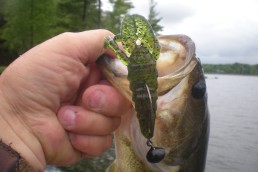A ‘Must-Have’ Jig for 2024
SHARE THIS POST
Every so often, a bait comes along that makes you stop and think. For me, the in-line, silicone-skirted bass jig was massive. I had a friend who just got tired of cleaning weeds off the area where the line tied to the jig. Back then, the hook eye was at a 90-degree angle out of the top of the head. It resulted in absolute frustration, considering how many weeds are readily available in our Wisconsin lakes.
My friend went whole hog, bought a mold, and made his own heads where the hook eye came straight out the of front of the jig. Which resulted in a massive cutback on grass snagging on the line tie.
I used a bunch of his heads and was sold on them. I wasn’t ready to attack a mold with a cutting tool. But I did have a banana jig mold that was collecting quite a bit of dust due to the hook eye coming out the top of the head. So, I figured, if it’s just sitting there; what would happen if I applied a Dremel tool to it to see if I could make it more in-line and thus, fairly free from hanging on weeds?
It worked. And I’ve been using it for 25-plus years. Love it! Love it! Love it.
When Tommy Biffle won a major bass tournament with a new jig that featured a head that swung freely out the back of the football-shaped head, with a line tie that’s recessed to avoid hang up, I picked up a few, as I’m wont to do for new things to catch bass every year.
A 1/2-ounce head can be attached to a no. 4 wide-gap hook, like a Gamakatsu, then swing loose after a bait is attached. Baits like Berkley’s MaxScent Creature Hawgs are tailor-made for this type of setup. I’ve used MaxScent baits for a while now and am quite pleased with the results.
I was leery of the football head, as I have had more snags using football heads than I like. But, when I saw there was a mold for these swing jigs, I decided to buy one. It has cavities for 1/2-, 5/8-, 3/4-, 1 and 1 1/4-ounce heads, which can certainly get you to the bottom.
Initially, I wanted to fish river smallmouths when they went deeper in fall. I knew I’d be fishing rocky water, which normally eats jigs like a 10-year-old inhales cotton candy at a carnival. The key, I’ve found, is not to let the jig settle in the rocks. As soon as it hits bottom, start reeling as slowly as possible to keep contact with the bottom while not hanging up. And there are definitely fewer snags.
Are you enjoying this post?
You can be among the first to get the latest info on where to go, what to use and how to use it!
For me, the final seal came on the Wolf River several falls ago. I followed some friends who came up to visit and catch some smallmouths, but I’m not sure in which order. They were fishing along shallower rocks. After giving them a head start and watching, I thought that maybe they were overlooking deeper fish. It turned out, they were.
I tossed a 1/2-ounce swing jig, let it hit bottom and immediately started a slow retrieve across bottom. It’s nice when a plan comes together. I still get some snags, but that’s the price of doing business with fall smallmouths in their rocky world.
Recently, I’ve seen that another mold for smaller swing jigs features 1/8-, 3/16-, 1/4-, 5/16-, 3/8- and 7/16-ounce cavities. I had been looking for a way to fish from light to heavy, especially when finesse is the order of the day.
Both molds are made by Do-it Molds, Denver, Iowa, which offers a lot of molds to make jig designs that have joined the ranks of available tackle. Swing-wise, I can fish the heavier weights in deep or high water (rivers with a stronger current). And where I would have used an 1/8-ounce, Texas-rigged setup for tube fishing, I can now drag lighter swing jigs, especially in lower-water conditions with lighter current, or in finesse situations.
I’m pretty happy right now, just thinking about it. And I’m looking forward to hitting the water in 2024.
Get better results from the time you spend fishing. Use information from the pros found in every issue of MidWest Outdoors, available by subscribing on our website.
MWO
SHARE THIS POST
You may also like...
Nothing found.
Did you enjoy this post?
You can be among the first to get the latest info on where to go, what to use and how to use it!
Tom Luba
Tom Luba is a freelance outdoor writer living in New London, Wis. He has written about open water fishing for more than 35 years.
